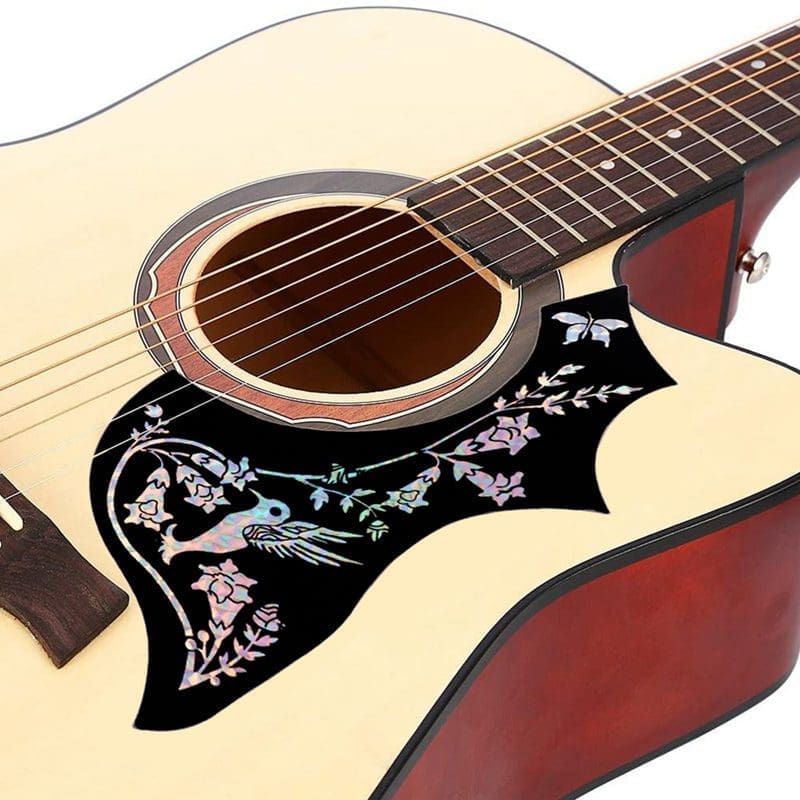Last update 5/2/2024
The acoustic guitar is a timeless instrument that has been enjoyed by musicians of all skill levels for generations. Its warm, rich sound is perfect for a variety of genres, from folk and country to rock and pop. But what exactly goes into making an acoustic guitar? And what are the different parts that make up this beloved instrument?
In this article, we’ll take a closer look at the anatomy of an acoustic guitar, explaining each of its key components and how they contribute to the overall sound and playability of the instrument. Whether you’re a beginner just starting out or a seasoned pro, this guide will give you a better understanding of how your guitar works and how to take care of it.
The acoustic guitar anatomy is often complex and sometimes mysterious. As a guitarist, it is advantageous for you to familiarize yourself with the components of different acoustic guitars. This guide will discuss all the major components of constructing an acoustic guitar. A basic understanding of how a guitar’s various components affect the sound and playability will make buying choices easier and ensure maximum enjoyment of the instrument.
Table of contents
- Construction of an acoustic guitar
- The Top or Soundhole
- The back
- The neck
- The Strings
- Steel strings
- Nylon strings
- Can steel strings be used on a nylon string guitar?
- The Position Markers
- The fretboard
- The Frets
- The Headstock
- Tuning keys
- The Nut
- Upper and lower bouts
- The Pickguard
- The Bridge
- The saddle
- String pegs
- Solid Wood vs.Layered Wood Construction
- Types of Acoustic Guitars | Body Shapes & Sizes
- Basic Guitar components
- Tonewoods in acoustic guitars
- Much to consider
- Hardwoods vs. Softwoods
- Hardwood Tops
- Fretboard Woods
- Budget compromise
- Tonewoods compared
- Indian Rosewood
- Tropical Mahogany
- Mahogany is ideal if:
- Maple is an excellent option if:
- Choose Sapele if:
- Consider Blackwood if:
- Ovangkol
- Consider ovangkol if:
- Hawaiian Koa
- Consider koa if:
- West African Ebony
- Top Woods
- Bright Tone vs. Dark Guitar Tone
- Why do solid wood guitars sound better with age?
- Acoustic guitar aesthetics
- Conclusion
Construction of an acoustic guitar
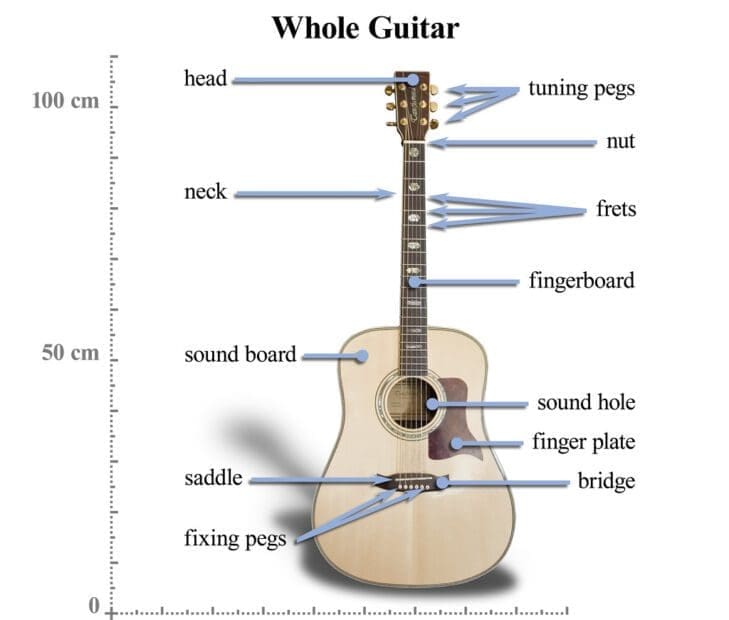

The Top or Soundhole
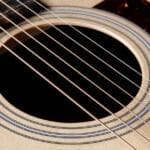

Also known as the soundboard. (The soundhole is within the guitar top). The top or soundboard is supported by special bracing. Bracing does affect the sound of an acoustic guitar by design.
The back
As the name implies, it is the back of the guitar’s body.
The neck
The neck is the longer half-round component for which the fretboard or fingerboard. It is joined to the body of the guitar.
The Strings
The all-important component for a guitar is the strings—the main difference between steel and nylon. Nylon is usually found on Classical guitars.
Steel strings


Steel strings have far more tension; hence, the guitar’s construction must allow that. A steel-string guitar will be louder and have more sustain than a nylon-string guitar. The gauge or diameter of the strings can be changed at times.
Nylon strings
An acoustic guitar designed for nylon strings will sound more mellow, not as loud, or have as much sustain—a player may find a nylon string guitar easier to play because it has less tension than a steel string.
Can steel strings be used on a nylon string guitar?
Never interchange the strings on a nylon-stringed guitar with steel strings. A nylon-stringed guitar has not been constructed to take steel strings. Significant damage is very likely to ensue.
There is no point in fitting nylon strings to an acoustic designed for steel strings. It is going to sound dull and lifeless.
The Position Markers
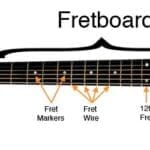

The position markers are also called inlays. Inlays mark the position of the frets at predetermined positions on the fretboard. The player then has a marker indicating the location of the 3rd, 5th, 7th, and 12th frets.
The fretboard
The fretboard is where the player places his fretting hand when playing the guitar. It is a separate component that is fixed to the neck. The fretboard also houses the frets placed at regular intervals across the fretboard.
The Frets
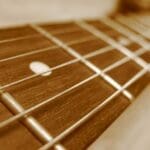

The purpose of frets is to change the pitch of a guitar string by the guitar player pressing the string down directly behind the fret. The frets are played across the length of the fingerboard at regular intervals.
The Headstock
The headstock is attached to the neck and supports the string tuners—the guitar strings wind around the pegheads. The pegheads will turn and loosen or tighten the guitar strings so that each individual is tuned to the correct pitch for each string.
Tuning keys
Machine heads are the mechanisms that turn the pegheads when tuning the guitar. The guitar tuners will vary in quality and might affect the guitar’s tuning stability.
The Nut
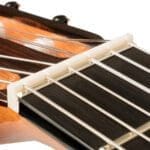

The nut is located at the bottom of the headstock. It is usually a white or off-white colored material fixed to the neck of the guitar. It allows the strings to sit in their groove in the nut. Hence it keeps the strings located evenly across the fretboard.
Upper and lower bouts
Are the curved sides of the body of the guitar. See the acoustic guitar glossary for more information on all the components of an acoustic guitar. There are many differences between the elements of an acoustic guitar. Be aware that various manufacturers design multiple parts differently, which affects the guitar’s sound.
The Pickguard
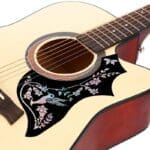

As the name applies, the pickguard protects the surface of the top of the guitar from scratches from the guitarist’s pick or fingernails. It is usually made from a type of plastic or tortoiseshell.
The Bridge
The bridge is located at the opposite end of the guitar, where the strings are fixed to the guitar top with bridge pins.
The saddle
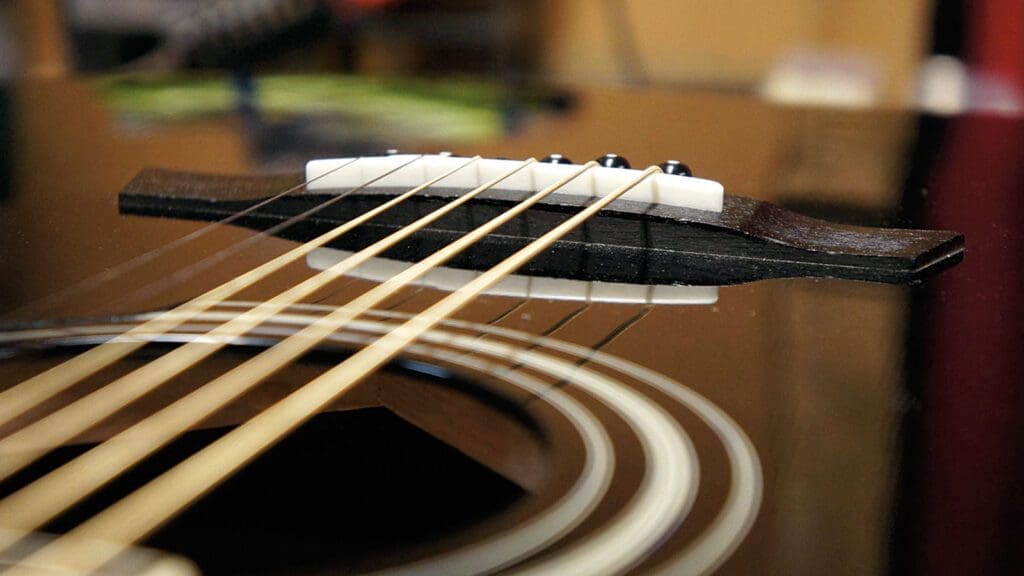

The saddle-like nut is fitted to the bridge. It has grooves cut into it to accommodate the guitar strings. The grooves are spaced evenly to maintain the correct spacing for the guitar strings.
String pegs
The string pegs locate and lock the strings into the bridge.
Solid Wood vs.Layered Wood Construction
One of the prominent features of the acoustic guitar is all solid wood construction or laminated. Solid wood is the preferred option, resulting in a better sound for the guitar. However, solid wood is the more expensive option because solid wood requires more intensive construction methods than a laminated guitar.
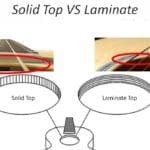

Laminated or layered wood is often made with a central core and external and internal layers. Layered wood acoustic guitars offer a tone slightly less complex than a solid wood guitar.
Laminated guitars usually are less expensive; therefore, they are a good option for budget-conscious purchasers. All acoustic guitars respond to humidity conditions, both high and low. One advantage of laminated guitars is their ability to contend with less-than-ideal humidity conditions.
Types of Acoustic Guitars | Body Shapes & Sizes


The three main acoustic guitars are the Dreadnaught (and its many variants), Jumbo, and Parlour.
The following acoustic guitars have essential differences, which must be considered carefully. Many companies sell different acoustic guitars; all have minor differences that should be considered.
Archtop acoustic


The Archtop acoustic is often used for Jazz. Archtops deliver a very focused sound with minimal sustain. Those are features that work well in Jazz. It’s a guitar that does not sound like a flattop acoustic guitar. However, it does offer sonic features sought after for Jazz.
Concert acoustic
Concert acoustic guitars are slightly smaller than a dreadnought. Tonally, they are strong in the upper and middle frequencies. The body is a comfortable acoustic, especially for the smaller framed guitarists. Its shorter scale makes fretting easier. They are great for fingerstyle players.
Classical acoustic (Nylon Strings)
Classical guitars are fitted with nylon strings and have a distinctive warm tone. They are sized similarly to a parlor-sized guitar. Nylon string acoustics use lower string tension than steel-string acoustics. Classical guitars use a wider nut than steel guitars.
Dreadnought acoustic
The Dreadnought is a famous large-bodied acoustic guitar. They offer a big, full-bodied sound with solid bass. The Dreadnought was an acoustic guitar concept developed by C.F. Martin & Company in 1916. The name Dreadnought was derived from a battleship of the same name, HMS Dreadnought, in 1906. Its distinguishing features are its large size, square shoulders, and bottom. Dreads are known for their loud, rich, and deep, and some might say boomy sound as they have become known.


Dreadnoughts are great for genres such as Bluegrass, country, folk, pop, and acoustic rock. The Dreadnought is one of the most copied guitar styles on the market. The main complaint about Dreads is that they can feel large and cumbersome to play for some. The main reason is the Dreadnought’s less-rounded waist.
The Martin D-28 is an iconic guitar in the world of acoustics. For many, it is the definitive acoustic guitar. It generally has a spruce top and mahogany or rosewood back and sides. The Dreadnought is a model that is a bit big for some. However, we believe that every prospective buyer of an acoustic guitar should try it for themselves.
Jumbo acoustic
As the name implies, these are huge guitars with a huge sound—not recommended for smaller-framed players.
Concert acoustic
Many concert guitars have a long and rich history. They are in the smaller-bodied category, which makes them comfortable to play. They are known for a bright sound with a strong mid-range
Grand Auditorium acoustic
A Grand Auditorium acoustic shape is an excellent choice for Flatpicking, fingerpicking, or strumming. Its sound is clear and prominent. Tonally, it has well-defined trebles, mids, and lows. It is an excellent all-rounder guitar.
Grand concert acoustic
The Grand Concert is a comfortable guitar to play, especially when seated. It’s an excellent option for fingerstyle players for home or stage players alike. A shorter scale length makes it easier to play.
Flamenco
Flamenco is designed to play the Flamenco music genre. They incorporate features to support the Flamenco style of playing. They have tap plates fitted to the guitar’s top to facilitate the tapping style, which is a big part of the Flamenco music playing style. Similar to Classical guitars, Flamenco guitars also use a wider neck.
Jumbo acoustic
The Jumbo acoustic guitar is excellent for the predominately strumming guitar player. It is a nice big sound down low yet retains clarity in the upper frequencies.
12 String acoustic guitars
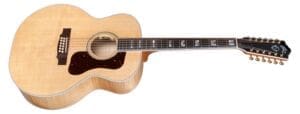

Acoustic CutawaysCutaways are trendy guitars; the term cutaway is used because part of the body is “cutaway” to allow the fretting hand to access the upper frets.
Purists believe that the sound of cutaways is affected because of the shape of the guitar. Technically, perhaps that may be correct. In practice, perhaps not. If you are a guitar player who does not need access to the higher frets, a cutaway would be of no benefit to you.
Acoustic-electric guitars
The acoustic-electric guitar is essentially an acoustic guitar with an electric guitar pickup and its controls built into the guitar.
These guitars are ideal for anyone who wants an acoustic guitar but requires more volume for various playing situations.
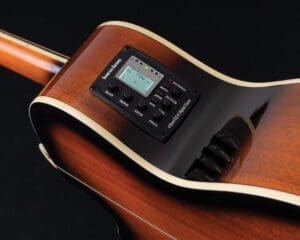

Ideal for the gigging guitar player who wishes to play at venues where a standard acoustic may not be loud enough. I.e., open venues such as street performing.
The cost of an acoustic-electric will be higher due to all the electronics.
An acoustic-electric can be plugged into a PA system or an amp. Also, consider the cost of an amplifier in your budget for this option. Many acoustic-electric is fitted with tone and volume controls and a tuner. Having the ability to adjust the guitar’s tone is a great asset.
Tone controls do not stop with the built-in onboard controls. Like an electric guitar, adding external effects like reverb, delay, and other flavors gives you a new sonic palette with which to experiment.
OOO Acoustic
Acoustic designated as ‘OM” is a size between a Dreadnought and a Parlor. It has a relatively small waist and elongated upper and lower bouts. It’s a good choice for fingerstyle and strumming.
Travel acoustic guitars
Minis such as the Taylor Mini GS are hugely popular with guitarists. A more petite body does not equate to a lower volume loss of quality.
However, popular with guitar players who frequently travel, many buy the Taylor Mini because they are often great-sounding and more comfortable than prominent-bodied acoustic guitars.
Parlor Acoustic
The parlor acoustic guitar is known for its focused high-end midrange. It’s great for fingerstyle comfort because of its smaller size.
Acoustic guitars | Important considerations
Basic Guitar components
The neck
We want to emphasize the importance of the right neck. It must feel comfy in your hands.
Chunky vs. Slim
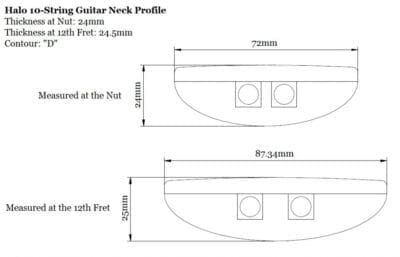

In straightforward terms, some guitars have chunky (baseball bat) necks. Other guitars may have slimmer necks.
If the neck is right, it should feel easy to form chords anywhere on the length of the neck. The size of the player’s hand will vary a lot from small to large.
Generally, a slimmer guitar neck is easier to use for most players.
Width of the neck
The width of a guitar neck is measured at the nut. A wide neck allows the strings to be wider apart than a narrow neck.
A narrow neck will make it easier for players with small hands to make Barr chords.
A medium that allows a balance, not too wide yet easy to fret the strings cleanly.
A wider neck might appeal to a fingerstyle player with big hands or long fingers. (Traditionally, Classical guitars have very wide necks. 2 or more inches is not uncommon.
The guitar’s action
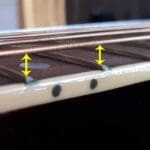

The action refers to the spacing between the frets and the string. Guitars with lower action are easier to fret. However, if the string spacing is insufficient, the strings will buzz because they may contact the fret.
The guitar’s intonation
Intonation refers to all the strings when fretted on any position on the fretboard, which will sound the note correctly. If the intonation were incorrect, one or more notes would sound out of tune.
The Nut
The nut is located at the top of the neck, where the fretboard meets the headstock. Furthermore, the nut is grooved to accommodate each of the guitar strings. The strings are located in their groove through a tuning peg and tuner hole.
Headstock
The headstock locates the strings of the guitar tuning pegs and tuning keys.
Body style
Guitars are built in various sizes, from small and cozy to large with big curves.
Scale length


A guitar’s scale length refers to a measurement taken from the guitar’s nut to the bridge. Scale length is an important specification to consider when choosing a guitar—a longer scale length guitar results in the strings requiring a higher tension.
A short-scale length guitar results in the guitar’s strings with less tension. The fret spacing is closer, making stretching the fingers onto a fret easier.
A guitar’s scale length will make an appreciable difference to the guitar’s playability. If you are a guitar player with small hands, a guitar with a shorter scale length.
Tonewoods in acoustic guitars
An acoustic guitar is built with various types of woods called Tonewoods, which will influence the sound of an acoustic guitar depending on where and how they are used. Think about tonewoods like the ingredients of a cake. Tonewoods are flavors for the guitar.
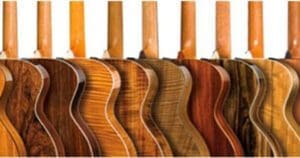

Tonewoods have different physical properties, which will translate into the tonal characteristics of the wood. Tonal woods can be thought of as ingredients in a cookbook.
Various tonewoods are used as tonal flavors to use as an analogy. That being the case, tonal woods are selected for their tonal flavors. The tonewoods used for the top, sides, and back are especially important.
Much to consider
When buying a guitar, the choice of tonewoods should be carefully considered. Tonal woods influence a guitar’s sound due to the varying degrees of density and stiffness. Those characteristics will influence the sounds of the guitar’s bass, midrange, treble, and sustain.
“‘Flying In A Blue Dream’ was quite automatic. I was working on another song, and I took a break, picked up my acoustic guitar, tuned it strangely, and instantly wrote the tune. It’s funny how you can struggle with one piece and write a better one in a minute. Usually, when things come easy, it means it’s good.” Joe Satriani
Reviewing the specs of a guitar and determining the type of tonewoods can guide someone about how that guitar might sound.
Hardwoods vs. Softwoods
Tonewoods may be grouped into categories such as hard and softwoods. Hardwoods have a higher density. Hardwood such as mahogany, rosewood, koa, and maple is often used for the back and sides of acoustic guitars. Softwoods are lightweight but have high tensile strength.


These are characteristics desired for the top or soundboard of the guitar. Typically, these woods used are cedar, spruce, or redwood. Sitka spruce, in particular, is a very popular tonewood for a guitar’s top.
The result is a crisp guitar with a clear tone and excellent sustain and dynamic range. Furthermore, hardwoods are also used for guitar tops, usually made with mahogany or koa.
Hardwood Tops
Hardwood-top guitars, such as an all-koa or mahogany-top model, produce a natural compression so that they will not yield as quick a response as a spruce-top guitar will.
- There tends to be more of a controlled, sustaining “roll-in” effect to a note.
- Mahogany-top guitars will produce strong fundamentals with a clear and direct focus.
- Hardwood’s natural tonal compression will help even out the response of an aggressive strummer.
- Because of their slightly denser nature, all Koa guitars will sound similar to mahogany but with more shimmer and chime in the upper register.
- Guitar players with intense picking or strumming can often “dig in” on a hardwood top guitar without overdriving.
Fretboard Woods
True to its name, a guitar’s slotted fretboard holds the frets in place. Ebony is widely used in the acoustic guitar world due to its density. Ebony is an excellent choice for fretboards because it holds frets exceptionally well, and its density provides resilience in the face of the rigors of fretting the strings.
Some guitar makers use rosewood fretboards (even more so in the electric guitar world); Taylor Guitars have said they find “rosewood is less resilient than ebony because it has a lower density.”
Budget compromise
Inexpensive guitars sometimes incorporate fretboards made of Richlite, a composite material. True to its name, a guitar’s slotted fretboard holds the frets in place. Ebony is widely used in the acoustic guitar world due to its density. Ebony is an excellent choice for fretboards because it holds frets exceptionally well, and its density provides resilience in the face of the rigors of fretting the strings.
Some guitar makers use rosewood fretboards (even more so in the electric guitar world);
Taylor Guitars has said that “rosewood is less resilient than ebony because it has a lower density.”
Inexpensive guitars sometimes incorporate fretboards made of Richlite, a composite material.
Tonewoods compared
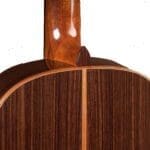

When discussing the various tonal properties of wood it is defined in terms of the wood’s frequency range.
- Low-end frequencies
- Midrange frequencies
- High-end frequencies.
Acoustic guitar’s tonal woods defined – back and sides
Indian Rosewood
A rich, musical tone with ringing overtones adds complexity and sustain. It has a broad range of deep lows, bell-like highs, and a slightly scooped midrange. It is known as one of the most enduring and popular tonewoods.
Indian Rosewood is known for its rich, “high-fidelity” acoustic voice with solid bass and treble; it has complex overtones and offers plenty of sustain. Rosewood is a very versatile tonewood, ideal for various playing styles.
Tropical Mahogany
Its tonal characters are known for their excellent midrange, often described as punchy, woody, or dry, all without many ringing overtones.
- To have a more controlled response that responds well to a strong playing attack can subdue the harshness of a heavy strummer.
- Clear and forthright tonal character. At times an excellent option for playing with other instruments
- It is sometimes called an earthy, low-fi sound compared to rosewood’s gorgeous, richer, high-fidelity characteristics.
- Mahogany guitars are often featured on many roots music recordings, from country blues to folk to rock.
Mahogany is ideal if:
You like a clear, direct tone with many mid-range rootsy characters. It’s a good guitar wood to try if you’re unsure what tonal personality you want. Its controlled response makes it a forgiving wood for beginner-level players.
It has been highly Revered in the bowed instrument world over the centuries because of its linear, transparent response; it reflects the player rather than imposing its personality.
It is traditionally considered that Maple offers a clean, bright, and focused tone; it offers a quick attack and short note decay that cuts through a mix exceptionally well.
Furthermore, the wood produces warmth, complexity, volume, sustain, responsiveness, and overall versatility while retaining maple’s naturally evident qualities.
Maple is an excellent option if:
You want a tremendous all-around wood that can respond well to various playing styles. Maple is known to have a brighter sound with less warmth or sustain.
- Alternative to mahogany, with extra top-end sparkle
- Consistent and well-balanced output across the tonal spectrum
- Compatible with a diverse range of playing styles
Choose Sapele if:
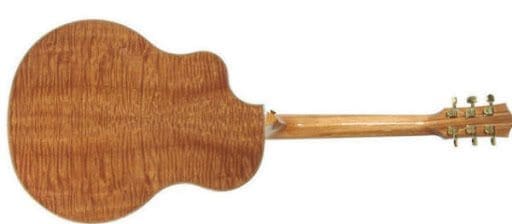

You want a versatile-sounding guitar with good clarity and overall balance. It is very similar to mahogany. However, it has a bit more top-end. Sapele guitars are more affordable because they don’t have as established heritage as mahogany.
- Substantial volume and midrange focus with a dry yet clear warm, similar to mahogany and koa woods.
- Top-end shimmer with a richness similar to rosewood
- Its all-around musicality suits a variety of body sizes and playing styles
Consider Blackwood if:
You’re looking for a great all-around acoustic sound. Furthermore, Blackwood responds well to various playing styles, making it a versatile performer. Its solid tonal output makes it a dynamic voice that responds well to lively strumming.
Fingerstyle players will love the clarity, warmth, and top-end shimmer. It is an excellent choice for recording and live performance applications.
Ovangkol
An African relative of rosewood, it shares many tonal qualities, including a broad tonal spectrum from lows to highs
Slightly fuller midrange and treble response than rosewood, similar to Koa
a popular choice among players at every level
Consider ovangkol if:
You like the sound of rosewood with a little more midrange. Ovangkol’s versatility makes it an excellent choice for various playing styles. And because it’s a lesser-known wood than rosewood, an ovangkol guitar may be more affordable.
Hawaiian Koa
Prized for their exotic visual appeal, guitar sets are often beautifully figured.
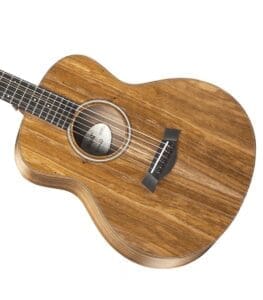

Fairly dense tropical hardwood shares the same tonal properties as mahogany, i.e., a strong midrange with extra high-end brightness and a beautiful chime.
The more playing time a Koa guitar receives and the more the wood ages, the warmer and sweeter its voice becomes.
Consider koa if:
You’re inspired by the visual appeal of exotic-looking woods and crave midrange tones with a bit of extra top-end brightness. Remember, a Koa guitar will age gracefully, rewarding you with a sound that improves with time.
West African Ebony
Dense tonewood produces clear, articulate notes with solid volume and projection.
Rich, ringing overtones that respond to a light touch or heavy playing
Linear quality across the tonal spectrum for a very balanced sound
Consider West African ebony if You’re a fingerstyle player who loves ringing, sustained overtones or a heavy strummer who needs a strong attack and a presence that can cut to the front of a mix.
Top Woods
The type of wood used in constructing an acoustic guitar is important as it affects the guitar’s tonality.
Sitka Spruce
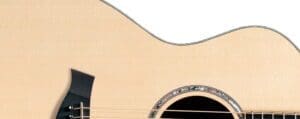

The most commonly used wood for tops because it’s light and stiff in the right ways, especially when quartersawn
- Its lighter weight gives the top the freedom to move, which helps translate the player’s picking or strumming into a clear acoustic tone.
- Generates a broad dynamic range
- Accommodates an abundance of playing styles, from aggressive strumming to light fingerpicking
It goes well with:
Virtually every playing style. You might consider Adirondack spruce if you have an extremely aggressive strumming or picking style. Cedar is a good alternative if you have an exceptionally light touch or play fingerstyle.
Lutz Spruce
- It is a naturally occurring hybrid of the Sitka and White/Engelmann spruce.
- Blends tonal characteristics of Sitka and Adirondack spruce to produce extra power, richness, and volume
- The midrange tones tend to have a slightly richer, sweeter quality
It goes well with:
Players with a driving attack who crave strong acoustic horsepower and dynamic range.
Western Red Cedar
Less dense than spruce.
- Its relative softness adds warmth to a guitar’s tone, especially for players with a lighter touch, like fingerstyle players or light to moderate strummers and pickers.
Players with a more vigorous attack are often better paired with spruce. - Cedar pairs well with nylon-string models because of its responsiveness to the strings, producing less overall energy than a steel-string guitar.
It goes well with:
Fingerstyle players and players with a light picking or strumming touch crave a warm, responsive sound.
Sinker Redwood
- A tight grain structure leads to a bold, punchy response with plenty of volume.
- Brilliant high-end complemented by warm overtones similar to cedar
- There is high headroom for aggressive playing without topping out
It goes well with:
- Players seek a richly variegated visual aesthetic with a powerful output and a responsive, woody low end.
- Different Types of Acoustic Guitars | Tones Bright and dark
Bright Tone vs. Dark Guitar Tone


An acoustic guitar tone is often bright or dark. A trait is usually due to tonewoods used to construct the guitar or playing style. Picks can also cause a dark or bright tone.
Bright tone
An acoustic guitar’s tones are often described differently. A bright tone, treble emphasis, or lots of top ends. It’s a tone that you can hear by playing very close to the bridge. The closer to the bridge you play, the brighter and thinner the sound. Note: Thin pics can also contribute to a bright and light sound.
Dark tone
A dark sound emphasizes the bass and a more significant low end. Furthermore, a dark tone can also be heard if you use a thick pick. The darker the tone will become as you play closer to the neck.
Experienced players use various picking positions as part of their sonic variations or, if you like, palettes.
Why do solid wood guitars sound better with age?
A characteristic of high-quality, solid-bodied guitars is that their sound will improve as they age. Guitarists have discussed much about solid-body guitars breaking in or requiring time to play before they reach their best sound.
This is said to be due to the wood, which has a degree of stiffness, becoming more relaxed because of the vibration from the strings over time. This is a phenomenon that is said to occur when played regularly.
The aging process for the guitars varies with the type of wood used to construct the guitar. Furthermore, hardwoods with a high density tend to take longer to break in. A high-quality guitar has been built from quality sold wood construction is said to improve its sound with age.
That is why an all-solid-body guitar is said to improve over time.
Acoustic guitar aesthetics
The visual elements
The visual appointments can add that touch of class to an acoustic guitar. At the same time, the instrument’s tonality and playing comfort are the most crucial features of your guitar. A guitar’s visual aesthetic plays a role in the total package for the guitar. After all, a guitar provides a multi-sensory experience.
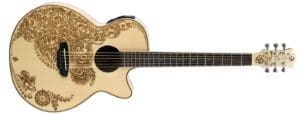

Visual enhancements range from clean and straightforward to detail-rich. Sunbursts are very popular and have many variations. You might opt for wood inlays and bindings. Abalone trim might be a good option, or pearl inlays all contribute to the visual appeal of the guitar.
Woods
Woods offers beautiful grain color variegation.
Inlay areas
Fretboards, peghead, and rosette.
Inlay materials


Abalone, Ivoroid, mother-of-pearl, and wood.
Body Bindings and Purflings
Ivoroid, wood, plastic, and various other materials.
Guitar finish


- Satin, matte, Gloss
- Color treatments
- Edge burst, Sunburst, custom color treatments.
Conclusion
Acoustic guitars are complex, carefully crafted instruments. A complex array of building techniques determines each acoustic guitar’s unique sound. Having at least a rudimentary understanding of how acoustic guitars are constructed will make buying the right one much easier.
What makes an acoustic guitar so popular is its versatility. Play it anywhere, anytime; the almost infinite variety of tones available from various types of acoustic guitars makes it attractive for many. There is an acoustic guitar for everyone to suit almost all musical tastes and high or low budgets. If you are thinking about procuring an acoustic, take your time, play as many as you can, and enjoy the hunt.
Transparency disclosure: Some of the links in this post are affiliate links, meaning that I may earn a commission if you click on a link and make a purchase. This commission comes at no extra cost to you. We only recommend products and services that I believe are helpful and valuable, and we never let the potential for a commission influence our recommendations.
Transparency disclosure: Some of the links in this post are affiliate links, meaning that I may earn a commission if you click on a link and make a purchase. This commission comes at no extra cost to you. We only recommend products and services that I believe are helpful and valuable, and we never let the potential for a commission influence our recommendations.

